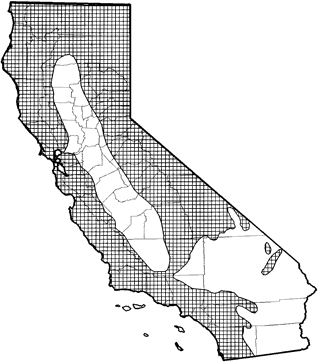
Fringed Myotis
Distribution, Abundance, and Seasonality
The fringed myotis is widespread in California, occurring in all but the Central Valley and Colorado and Mojave deserts. Its abundance appears to be irregular; it may be common locally. It occurs in a wide variety of habitats; records range in elevation from sea level to 2850 m (9350 ft) in New Mexico (Barbour and Davis 1969). Optimal habitats are pinyon-juniper, valley foothill hardwood and hardwood-conifer, generally at 1300-2200 m (4000-7000 ft).

Range Map
Specific Habitat Requirements
Feeding: Feeds mostly on beetles, and also on moths, arachnids, and orthopterans (Black 1974). Foraging flight is slow and maneuverable, and capture may utilize wing and tail membranes. This species is capable of hovering, and occasionally may land on the ground. Feeds over water, over open habitats, and by gleaning from foliage.
Cover: The fringed myotis roosts in caves, mines, buildings, and crevices. Separate day and night roosts may be used. Adults and subadults generally form separate groups in the roost.
Reproduction: Maternity colonies of up to 200 individuals are located in caves, mines, buildings, or crevices. Adult males are absent from maternity colonies, which are occupied from late April through September. Maternity group members may remain together during hibernation.
Water: Requires water; has a low urine-concentrating ability (Studier et al. 1970).
Pattern: Uses open habitats, early successional stages, streams, lakes, and ponds as foraging areas.
Species Life History
Activity Patterns: Nocturnal. Hibernates. This species is active from shortly after sunset to 4-5 hr after sunset. Most activity is from 1-2 hr after sunset. Wind and precipitation reduce activity. The period of hibernation lasts from October through March. Pregnant and lactating females may be heterothermic as an energy saving strategy (Studier et al. 1973).
Seasonal Movements / Migration: This species is migratory, making relatively short, local movements to suitable hibernacula.
Home Range: No data found.
Territory: Probably not territorial. May be found singly or in colonies.
Reproduction: Mating occurs in the fall, followed by delayed fertilization. Gestation lasts 50-60 days. The young are born from May through July, but most are born in late June. A single offspring is produced per yr. Lactating females are found in July and August. Young females are mature in their first yr, males are mature in their second yr. The maximum longevity recorded is 18.3 yr (Tuttle and Stevenson 1982).
Niche: Sympatric with many other species. This species is a slow, maneuverable flier, and uses foliage gleaning. Possible predators include owls and snakes.
Comments: The fringed myotis is easily disturbed at roosting sites.
Sources & References
California Department of Fish and Game, 1999.
California's Wildlife, Sacramento, CA.
Written by: J. Harris, reviewed by: P. Brown, edited by: D. Alley, R. Duke
Baker, J. K. 1962. Notes on the Myotis of the Carlsbad Caverns. J. Mammal. 43:427-428. Barbour, R. W., and W. H. Davis. 1969. Bats of America. Univ. of Kentucky Press, Lexington. 286pp. Black, H. L. 1974. A north temperate bat community: structure and prey populations. J. Mammal. 55:138-157. Cockrum, E. L., and E. Ordway. 1959. Bats of the Chiricahua Mountins, Cochise County, Arizona. Am. Mus. Novitates. 1938:1-35. Easterla, D. A. 1966. Yuma myotis and fringed myotis in southern Utah. J. Mammal. 47:350-351. Findley, J. S., A. H. Harris, D. E. Wilson, and C. Jones. 1975. Mammals of New Mexico. Univ. New Mexico Press. Albuquerque. 360pp. Hoffmeister, D. F. 1970. The seasonal distribution of bats in Arizona: a case for improving mammalian range maps. Southwest. Nat. 15:11-22. Hoffmeister, D. F.,and W. W. Goodpaster. 1954. The mammals of the Huachuca Mountains, southeastern Arizona. III. Biol. Monogr. 24:1-152. Jones, C. 1965. Ecological distribution and activity records of bats of the Mogollon Mountains area of New Mexico and adjacent Arizona. Tulane Studies Zool. 12:93-100. O'Farrell. M. J., and E. H. Studier. 1973. Reproduction, growth and development in Myotis thysanodes and M. lucifugus (Chiroptera: Vespertilionidae). Ecology 54:18-30. O'Farrell, M. J., and E. H. Studier. 1975. Population structure and emergence activity patterns in Myotis thysanodes and M. lucifugus (Chiroptera: Vespertilionidae) in northeastern New Mexico. Am. Midland Nat. 93:368-376. O'Farrell, M. J., and E. H. Studier. 1980. Myotis thysanodes. Mammal. Species No. 137. 5pp. Orr, R. T. 1956. The distribution of Myotis thysanodes in California. J. Mammal. 37:545- 546. Roest, A. I. 1951. Mammals of the Oregon Caves area, Josephine County. J. Mammal. 32:345-351. Studier, E. H., J. W. Proctor, and D. J. Howell. 1970. Diurnal body weight loss and tolerance of weight loss in five species of Myotis. J. Mammal. 51:302-309. Studier, E. H., V. L. Lysengen, and M. J. O'Farrell. 1973. Biology of Myotis thysanodes and M. lucifugus (Chiroptera: Vespertilionidae)--II. Bioenergetics of pregnancy and lactation. Comp. Biochem. Physiol. 44:467-471. Tuttle, M. D., and D. Stevenson. 1982. Growth and survival of bats. Pages 105-150 in T. H. Kunz, ed. Ecology of bats. Plenum Publ. Co., New York. 425pp. Whitaker, J. O., Jr., C. Maser, and L. E. Keller. 1977. Food habits of bats of western Oregon. Northwest Sci. 51:46-55.
California Animal Facts | California's Wildlife